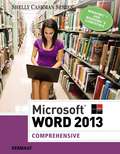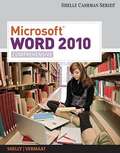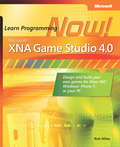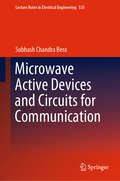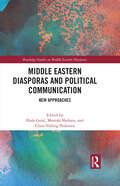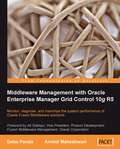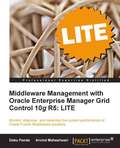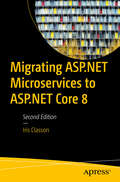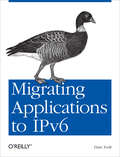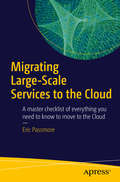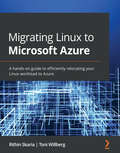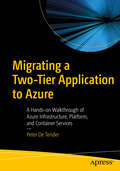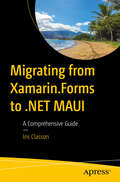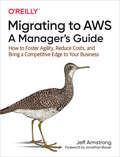- Table View
- List View
Microsoft® Word 2010, Introductory
by Beth Pasewark Wadsworth Carolyn Denny Pasewark Jan Pasewark Stogner Katherine T. Pinard Scott G. Pasewark William R. PasewarkMicrosoft Word 2010 Introductory, part of the Origins Series, is designed for beginning users of Microsoft Office 2010. This self-paced, step-by-step book with corresponding screenshots makes learning easy and enjoyable. Students will learn the new features of excel through a variety of activities, simulations, and case studies. End-of-lesson exercises reinforce the skills covered in each lesson.
Microsoft® Word 2013: Comprehensive
by Misty E. VermaatIntroduce your students to the latest that Microsoft Office has to offer with the new generation of Shelly Cashman Series® books! For the past three decades, the Shelly Cashman Series has effectively introduced computer skills to millions of students. With MICROSOFT WORD 2013, we're continuing our history of innovation by enhancing our proven pedagogy to reflect the learning styles of today's students. In this text you'll find features that are specifically designed to engage students, improve retention, and prepare them for future success. Our trademark step-by-step, screen-by-screen approach now encourages students to expand their understanding of MICROSOFT WORD 2013 through experimentation, critical thought, and personalization. With these enhancements and more, the Shelly Cashman Series® continues to deliver the most effective educational materials for you and your students.
Microsoft® Word® 2010: Comprehensive
by Gary B. Shelly Misty E. VermaatMicrosoft Office Word 2010: Comprehensive provides a project-based, step-by-step approach to successfully teach students Microsoft Word 2010 skills.
Microsoft® XNA® Framework Edition: Programming Windows® Phone 7
by Charles PetzoldNOTE: This book is the printed, XNA-focused edition of Programming Windows Phone 7, which is available as a free eBook from the Microsoft Download Center. A Microsoft Silverlight®-focused edition is also available for sale in print (ISBN 978-0-7356-5667-3). The Microsoft eBook covers both XNA and Silverlight in one volume. Bring your game ideas to life--with guidance from a Windows programming legend Begin creating your own game apps for Windows Phone 7--guided by the consummate teacher, award-winning author Charles Petzold. Focusing on the XNA 2D framework and the C# language, you'll learn how to extend your existing skills--mastering core concepts and techniques for this new mobile platform. As always, Charles brings a unique combination of pragmatism and inspiration to his instruction--along with a wealth of hands-on examples. Discover how to: Develop high-performance XNA 2D games Create and animate text and sprites Capture and embed bitmaps, balancing performance issues Support multi-touch input--including tap, drag, flick, and pinch Manipulate bitmaps at the pixel level Apply dynamic textures Work with transforms Put components together for touch-and-play and tilt-and-play games Test-drive your game on Windows Phone Emulator Get code samples on the Web For system requirements, see the Introduction.
Microsoft® XNA® Game Studio 4.0: Learn Programming Now!
by Rob MilesNow you can build your own games for your Xbox 360®, Windows® Phone 7, or Windows-based PC--as you learn the underlying concepts for computer programming. Use this hands-on guide to dive straight into your first project--adding new tools and tricks to your arsenal as you go. No experience required! Learn XNA and C# fundamentals--and increase the challenge with each chapter Write code to create and control game behavior Build your game's display--from graphics and text to lighting and 3-D effects Capture and cue sounds Process input from keyboards and gamepads Create features for one or multiple players Tweak existing games--and invent totally new ones
Microstock Photography: How to Make Money from Your Digital Images
by Douglas FreerBe a part of one of the world's fastest growing imaging phenomenons: microstock photography. Microstock photography provides both professional and amateur photographers an opportunity to diversify their income and expand their artistic visibility by turning day trip photos or photography portfolios into viable business investments.Douglas Freer has written a comprehensive book that details the technical and commercial processes of the microstock industry. A must read for entrants into the microstock photography field, Microstock Photography shows you how to: .Choose the right microstock agency.Shoot work that will sell.Navigate the strict technical requirements.Understand the likely financial returns.Review licensing models.Understand copyright issuesOver 60 illustrations and photographs help you improve your skills, learn new techniques specific to shooting stock photography and better understand what the microstock market demands. Anyone can shoot digital stock photography, but in order to make money and be successful, you need the practical advice that can only be found in this book.
Microsystems Dynamics
by Vytautas Ostasevicius Rolanas DaukseviciusIn recent years microelectromechanical systems (MEMS) have emerged as a new technology with enormous application potential. MEMS manufacturing techniques are essentially the same as those used in the semiconductor industry, therefore they can be produced in large quantities at low cost. The added benefits of lightweight, miniature size and low energy consumption make MEMS commercialization very attractive. Modeling and simulation is an indispensable tool in the process of studying these new dynamic phenomena, development of new microdevices and improvement of the existing designs. MEMS technology is inherently multidisciplinary since operation of microdevices involves interaction of several energy domains of different physical nature, for example, mechanical, fluidic and electric forces. Dynamic behavior of contact-type electrostatic microactuators, such as a microswitches, is determined by nonlinear fluidic-structural, electrostatic-structural and vibro-impact interactions. The latter is particularly important: Therefore it is crucial to develop accurate computational models for numerical analysis of the aforementioned interactions in order to better understand coupled-field effects, study important system dynamic characteristics and thereby formulate guidelines for the development of more reliable microdevices with enhanced performance, reliability and functionality.
Microtechnology for Cell Manipulation and Sorting
by Wonhee Lee Peter Tseng Dino Di CarloThis book delves into the recent developments in the microscale and microfluidic technologies that allow manipulation at the single and cell aggregate level. Expert authors review the dominant mechanisms that manipulate and sort biological structures, making this a state-of-the-art overview of conventional cell sorting techniques, the principles of microfluidics, and of microfluidic devices. All chapters highlight the benefits and drawbacks of each technique they discuss, which include magnetic, electrical, optical, acoustic, gravity/sedimentation, inertial, deformability, and aqueous two-phase systems as the dominant mechanisms utilized by microfluidic devices to handle biological samples. Each chapter explains the physics of the mechanism at work, and reviews common geometries and devices to help readers decide the type of style of device required for various applications. This book is appropriate for graduate-level biomedical engineering and analytical chemistry students, as well as engineers and scientists working in the biotechnology industry.
Microwave Active Devices and Circuits for Communication (Lecture Notes in Electrical Engineering #533)
by Subhash Chandra BeraThe book discusses active devices and circuits for microwave communications. It begins with the basics of device physics and then explores the design of microwave communication systems including analysis and the implementation of different circuits. In addition to classic topics in microwave active devices, such as p-i-n diodes, Schottky diodes, step recovery diodes, BJT, HBT, MESFET, HFET, and various microwave circuits like switch, phase shifter, attenuator, detector, amplifier, multiplier and mixer, the book also covers modern areas such as Class-F power amplifiers, direct frequency modulators, linearizers, and equalizers. Most of the examples are based on practical devices available in commercial markets and the circuits presented are operational. The book uses analytical methods to derive values of circuit components without the need for any circuit design tools, in order to explain the theory of the circuits. All the given analytical expressions are also cross verified using commercially available microwave circuit design tools, and each chapter includes relevant diagrams and solved problems. It is intended for scholars in the field of electronics and communication engineering.
Middle Eastern Diasporas and Political Communication: New Approaches (Routledge Studies on Middle Eastern Diasporas)
by Ehab Galal Mostafa Shehata Claus Valling PedersenThis edited book explores the development and reconfiguration of Middle Eastern diasporic communities in the West in the context of increased political turmoil, civil war, new authoritarianism, and severe constraints on media in the Middle East. Taking an interdisciplinary approach, incorporating political and intercultural communication, the contributors investigate the rationale for diasporic politics, as well as the role of the transnational media in shaping diasporic political mobilization. This analysis of the media, situated within specific case studies, encompassing Afghani, Armenian, Bahraini, Egyptian, Lebanese, Syrian, Tunisian, and Turkish diasporic communities, reveals the variegated ways it influences diasporic politics and facilitates political action, as well as its influence on democratic actors residing in the Middle East. These new insights into Middle Eastern diasporas, political communication, and political mobilization are based on developments in the Middle East since 2011, and ultimately highlight how diaspora groups in the West relate to the situation in the Middle East, particularly in their countries of origin. The book is important reading for students and researchers working in political/intercultural communication and diasporic politics, as well as those with a general interest in the Middle East.
Middle Tech: Software Work and the Culture of Good Enough (Princeton Studies in Culture and Technology #36)
by Paula BialskiWhy software isn&’t perfect, as seen through the stories of software developers at a run-of-the-mill tech companyContrary to much of the popular discourse, not all technology is seamless and awesome; some of it is simply &“good enough.&” In Middle Tech, Paula Bialski offers an ethnographic study of software developers at a non-flashy, non-start-up corporate tech company. Their stories reveal why software isn&’t perfect and how developers communicate, care, and compromise to make software work—or at least work until the next update. Exploring the culture of good enoughness at a technology firm she calls &“MiddleTech,&” Bialski shows how doing good-enough work is a collectively negotiated resistance to the organizational ideology found in corporate software settings.The truth, Bialski reminds us, is that technology breaks due to human-related issues: staff cutbacks cause media platforms to crash, in-car GPS systems cause catastrophic incidents, and chatbots can be weird. Developers must often labor to patch and repair legacy systems rather than dream up killer apps. Bialski presents a less sensationalist, more empirical portrait of technology work than the frequently told Silicon Valley narratives of disruption and innovation. She finds that software engineers at MiddleTech regard technology as an ephemeral object that only needs to be good enough to function until its next iteration. As a result, they don&’t feel much pressure to make it perfect. Through the deeply personal stories of people and their practices at MiddleTech, Bialski traces the ways that workers create and sustain a complex culture of good enoughness.
Middleware Management with Oracle Enterprise Manager Grid Control 10g R5
by Debu Panda Arvind MaheshwariThis book is a hands-on tutorial detailing Oracle Enterprise Manager Grid Control's management of Middleware. It is a 'how-to', and provides best practices, tips, and troubleshooting guidelines for managing middleware with Oracle Enterprise Manager. This book is targeted at Middleware Administrators, IT Architects, and System Administrators who want to monitor, diagnose, and maximize the system performance of Oracle [if gte mso 9] Normal 0 false false false EN-US X-NONE X-NONE ![endif]--[if gte mso 9] ![endif] Fusion Middleware solutions. The book assumes basic knowledge of middleware/application server management. It can also be used by Database Administrators who want to become Middleware Administrators.
Middleware Management with Oracle Enterprise Manager Grid Control 10g R5: LITE
by Debu Panda Arvind MaheshwariWritten by senior members of the Oracle team, this book is a hands-on tutorial detailing Oracle Enterprise Manager Grid Control's management of Middleware. The material has been carefully selected from Packt's fuller 350 page "Middleware Management with Oracle Enterprise Manager Grid Control 10g R5". If you are a Middleware or System Administrator or an IT Architect who wants to maximize the system performance of Oracle Fusion Middleware solutions, then this book is for you. You'll also find it helpful if you are a DBA who wants to become a Middleware Administrator. You should have basic knowledge of middleware/application server management.
Middleware Solutions for the Internet of Things
by Flávia C. Delicato Paulo F. Pires Thais BatistaAfter a brief introduction and contextualization on the Internet of Things (IoT) and Web of Things (WoT) paradigms, this timely new book describes one of the first research initiatives aimed at tackling the several challenges involved in building a middleware-layer infrastructure capable of realizing the WoT vision: the SmartSensor infrastructure. It is based on current standardization efforts and designed to manage a specific type of physical devices, those organized to shape a Wireless Sensor Network (WSN), where sensors work collaboratively, extracting data and transmitting it to external networks to be further analysed and processed. Middleware Solutions for the Internet of Things describes this infrastructure and its RESTful-based programming model that allows developers create applications without having specific knowledge about physical devices or networking environments. It is also shown, step by step, how to create a Web Mashup application using SmartSensor.
Migrants, Refugees, and the Media: The New Reality of Open Societies (Global Interdisciplinary Studies Series)
by Sai Felicia Krishna-HenselThe large-scale movements of refugees and economic migrants from conflict zones to more stable societies have resulted in challenges, both for new entrants and their hosts. This fascinating volume brings together a collection of media analyses focused on immigration issues to examine how migration has been represented to the public. Case studies exploring media coverage of migrants and refugees in Europe enable the reader to better understand the complexity of the process through a range of unique and unexplored dimensions of immigration analysis, including strategic framing theory, game structure analysis, migration maps and routes, television narratives, rumour-based communication, and state-bred campaigns. The insights into the perspective of migrants, the general public and policy makers provide innovative methodological and theoretical analysis on population movements which will be of interest to scholars, students, and policy makers working in the fields of migration studies, international relations, peace and security studies, and social and public policy.
Migrating ASP.NET Microservices to ASP.NET Core 8
by Iris ClassonIn this second edition, you will be guided through the journey of migrating an ASP.NET Framework application to ASP.NET Core microservices. You will know how to master the following steps: Conduct an inventory, prepare the application, plan the migration, execute the migration, improve the deployment pipeline. For the detailed hands-on migration, the book uses a streamlined business application, derived from a real-world application that underwent the migration process a few years ago. In this second edition, the application has evolved to include more features relevant to the latest advancements in ASP.NET Core, such as minimal web APIs, Razor Pages, REST documentation, and enhanced authentication. The book also delves into the nuances of upgrading between ASP.NET Core versions, managing breaking changes, and incorporating significant new features. New in This Edition Enhanced sample application now showcases the application of gRPC, Minimal APIs, and OpenAI, reflecting the latest in ASP.NET Core technology Dedicated section focuses on upgrading ASP.NET Core applications, addressing both the challenges posed by breaking changes and the introduction of new features Deployment and CI/CD pipeline section has been expanded to include a minor section covering GitHub Actions, Docker containers, and other significant deployment improvements Maintenance chapter has been updated with a section on the ASP.NET Core release and support cycles, as well as an enhanced resources section now featuring AI developer tools What You Will Learn Effectively plan and execute a migration: Conduct an in-depth analysis, inventory and cleanup, decoupling logic, and break out new services, all while adhering to best practices such as the handler pattern, dependency injection, and more Use key ASP.NET Core features such as minimal Web API, Razor Pages, gRPC, and built-in authentication improvements Know other important features such as SignalR, EF Core, ASP.NET Core testing library for integration tests, Blazor and more Who This Book Is For Software developers, IT professionals, and system architects who are looking to transition their applications to ASP.NET Core; serves as a fundamental resource for those keen on modernizing their development practices and staying current with ASP.NET Core
Migrating ASP.NET Microservices to ASP.NET Core: By Example
by Iris ClassonMigrate your existing microservice cluster from ASP .NET to ASP .NET Core. While improved performance and cross-platform support are evident, this book helps you cut through the noise to determine how, when, and to what extent a migration is needed.Microsoft’s introduction of .NET Core has created a lot of excitement, but also a lot of confusion for developers accustomed to ASP applications and services. This book gives you specific steps to embark on a partial or full SaaS microservices system migration, factoring in limited resources, time, and finances. In addition to practical advice and real-world examples, many mishaps will be shared, providing you with a complete 360-degree view of a migration.As a developer intimately familiar with the migration process, author Iris Classon shares prescriptive guidance on every part of the system—from code, dependencies, editors, integration, and the deployment pipeline to a distribution model. You will come away with all the information you need to plan and prepare your migration to ASP.NET Core.What You’ll LearnConduct an in-depth, pre-migration analysis of your system Know the differences between ASP .NET and ASP .NET CorePlan for and execute a full or partial migration to ASP .NET Core Understand the continuous integration and deployment process Gain insight on tools and templates that will accelerate and facilitate the migration processLeverage a real-world migration example, complete with genuine challengesMigrate specific components such as logging, authentication, data access, and moreWho This Book Is ForDevelopers who are considering or are tasked with migrating an existing microservice cluster from ASP.NET to ASP.NET Core. Experience with C#, Web API, ASP.NET, Visual Studio, and PowerShell is helpful.
Migrating Applications to IPv6: Make Sure IPv6 Doesn't Break Your Applications
by Dan YorkIf IPv6 is to be adopted on a large scale, the applications running on desktop systems, laptops, and even mobile devices need to work just as well with this protocol as they do with IPv4. This concise book takes you beyond the network layer and helps you explore the issues you need to address if you are to successfully migrate your apps to IPv6. It's ideal for application developers, system/network architects, product managers, and others involved in moving your network to IPv6. Explore changes you need to make in your application's user interface Make sure your application is retrieving correct information from DNS Evaluate your app's ability to store and process both IPv6 and IPv4 addresses Determine if your app exposes or consumes APIs where there are IP address format dependencies Work with the network layer to ensure the transport of messages to and from your app Incorporate IPv6 testing into your plans, and use the correct IPv6 addresses in your documentation
Migrating Applications to the Cloud with Azure: Re-architect and rebuild your applications using cloud-native technologies
by Amit Malik Sander Rossel Sjoukje Zaal Mohamed Wali Jason MarstonModernize your apps with Microsoft Azure by moving web, desktop, and mobile apps to the cloud Key Features Decide which migration strategy is most suitable for your organization and create a migration roadmap Move existing infrastructure to Azure and learn strategies to reduce cost, increase storage, and improve ROI Design secure, scalable, and cost-effective solutions with the help of practical examples Book Description Whether you are trying to re-architect a legacy app or build a cloud-ready app from scratch, using the Azure ecosystem with .NET and Java technologies helps you to strategize and plan your app modernization process effectively. With this book, you'll learn how to modernize your applications by using Azure for containerization, DevOps, microservices, and serverless solutions to reduce development time and costs, while also making your applications robust, secure, and scalable. You will delve into improving application efficiency by using container services such as Azure Container Service, Azure Kubernetes Service (AKS), and more. Next, you will learn to modernize your application by implementing DevOps throughout your application development life cycle. You will then focus on increasing the scalability and performance of your overall application with microservices, before learning how to add extra functionality to your application with Azure serverless solutions. Finally, you'll get up to speed with monitoring and troubleshooting techniques. By the end of this book, you will have learned how to use the Azure ecosystem to refactor, re-architect, and rebuild your web, mobile, and desktop applications. What you will learn Use DevOps and containerization technologies to modernize your applications and infrastructure Build microservices using Azure Service Fabric Develop scalable applications using Azure Functions Manage and deploy your application code and database connectivity Secure and monitor your applications in Azure effectively Design for high availability and disaster recovery Who this book is for This book is for.NET and Java developers who want to modernize their applications using Azure. Solution architects and experienced developers interested in modernizing legacy applications using Azure will also find this book useful. Some prior understanding of cloud computing concepts will be beneficial.
Migrating Large-Scale Services to the Cloud
by Eric PassmoreThis book reveals the technical challenges and successful implementation details of migrating MSN, Microsoft's consumer content portal--a business with 450 million worldwide users--into the Cloud. Following a technique long used in aviation, medicine, and other fields, MSN's Chief Technical Officer, Eric Passmore, describes the set of release, deployment, monitoring, and mitigation checklists used to build cloud services supporting hundreds of millions of users on Azure, Microsoft's Public Cloud. An undertaking of this scale--involving services supported by a large team of engineers--involves unique challenges and risks. This book demonstrates through personal experience how to cut through the theory and provides checklists as a surprisingly simple antidote to the competing methodologies. This book works at two levels. At a fundamental level, businesses need to be successful in the cloud if they want to seize new opportunities and transform their business to compete successfully. This book provides a framework for success by identifying the "hidden" work as part of moving to the cloud. At a more practical, level there is an incredible hunger for simple to follow, "how-to" information on Cloud migration. This book is a reference guide to reduce risk and achieve success without requiring the busy reader to wade through theory. It contains simple to follow, "how-to" information on cloud migration. It is a reference guide to achieving success, and any team can modify these tasks to fit the needs of their own organization. What you'll learn Pre-Release checklist Deployment checklist Monitoring and Alerting checklist Incident Mitigation checklist Who this book is for Technology professionals who deploy services in the cloud or are thinking of moving to the cloud. Professionals in the DevOps and Cloud services fields need these skills to succeed in their current jobs or advance their careers.
Migrating Linux to Microsoft Azure: A hands-on guide to efficiently relocating your Linux workload to Azure
by Rithin Skaria Toni WillbergLearn to move on-premises virtual machines running on Linux servers to Azure with expert guidance, best practices, and optimized costKey FeaturesWork with real-life migrations to understand the do's and don'ts of the processDeploy a new Linux virtual machine and carry out automation and configuration managementLearn debugging your system and collecting error logs with hands-on examplesBook DescriptionWith cloud adoption at the core of digital transformation for organizations, there has been a lot of demand to deploy and host enterprise business workloads in the cloud. Migrating Linux to Microsoft Azure offers a series of actionable insights into deploying Linux workload to Azure.You will begin by learning about the history of IT, operating systems, Unix, Linux, and Windows, before moving on to look at the cloud and what things were like before virtualization. This will enable those not very familiar with Linux to learn the terms required to grasp the upcoming chapters. Furthermore, you will explore popular Linux distributions including RHEL 7, RHEL 8, SLES, Ubuntu pro, CentOS 7, and more.As you progress, you will dive into the technical details of Linux workloads such as LAMP, Java, and SAP. You will learn how to assess your current environment and plan migrating to Azure through cloud governance and operations planning.Finally, you will go through the execution of a real migration project and learn how to analyze, debug, and recover some common problems Linux on Azure users have encountered. By the end of this Linux book, you will be proficient in performing an effective migration of Linux workloads to Azure for your organization.What you will learnExplore the terminology and technology of various Linux distributionsUnderstand the technical support co-operation between Microsoft and commercial Linux vendorsAssess current workloads by using Azure MigratePlan cloud governance and operationsExecute a real-world migration projectManage project, staffing, and customer engagementWho this book is forThis book is intended to benefit cloud architects, cloud solution providers, and any stakeholders dealing with migration of Linux workload to Azure. Basic familiarity with Microsoft Azure would be a plus.
Migrating a Two-Tier Application to Azure: A Hands-on Walkthrough of Azure Infrastructure, Platform, and Container Services
by Peter De TenderUnderstand and build a proof of concept by migrating a multi-tiered .NET Core web application to the Azure public cloud, leveraging different Azure Infrastructure as a Service (IAAS), Azure Platform as a Service (PaaS), and Azure Container offerings. These include Azure Container Instance (ACI), Azure Kubernetes Services (AKS), and CI/CD pipeline deployments using Azure DevOps. After a first chapter in which you set up the baseline for the lab scenarios, you will start with the basics of automating Azure resource deployments using Visual Studio and powerful Azure Resource Manager (ARM) templates. Next, you’ll learn about the importance of performing proper assessments and the tools Microsoft offers to help in this migration preparation phase. After that, you will validate the virtual machine deployment and learn about SQL Server database migration to SQL Azure PaaS, as well as deploying and migrating web applications to Azure Web Apps. After covering these foundational platform components, the next chapters focus on the core concepts and advantages of using containers for running business workloads. These labs are based on Docker, Azure Container Registry (ACR), ACI, and Web App for Containers, and show you how to enable container orchestration and cloud-scale using AKS. In the last part of the book, you will work with Azure DevOps, the Microsoft application lifecycle environment, building a CI/CD pipeline to publish workloads using the DevOps principles and concepts. You’ll see the integration with the rest of the Azure services, closing with a module on overall Azure monitoring and operations and what tools Azure has available to assist your IT teams in this challenge.What You Will Learn Use Azure to enable digital transformation Carry out Azure automated deployments using ARM templates and Azure DevOps Run VM-based workloads on Azure Migrate VM-based workloads to Azure platform services Monitor Azure running workloads with Azure Monitor and Log Analytics Who This Book Is For Anyone who wants to learn about different Azure architectures by going through hands-on exercises.
Migrating from Drupal to Backdrop
by Todd TomlinsonMigrate an existing Drupal 6 or 7 website to Backdrop and discover why you should consider using Backdrop when building a new website. You'll learn what Backdrop is, how to install and configure Backdrop, and create and manage content. Migrating from Drupal to Backdrop focuses on the user who is responsible for building, maintaining, and managing an organization's website and who is interested in Backdrop's ability to meet their site's requirements. There is a major shift in the open source CMS market and Backdrop is emerging as a significant force. The Drupal team's decision to rebuild Drupal 8 on Symfony has many developers and organizations in a quandary - do you learn a whole new framework and undertake the effort of migrating to Drupal 8, stay on Drupal 7 which will at some point be officially unsupported, or adopt Backdrop as their go-forward strategic platform? There is also a large mid-market that may not have the ability to scale up with the skills required to support Drupal 8 (Symfony), making Backdrop a viable and attractive alternative. By reading this book, you will: Understand why you should use Backdrop and the power of the platform Quickly build confidence in your ability to use Backdrop Gain the knowledge necessary to build, deploy, and manage web sites of moderate complexity on Backdrop Understand the process for migrating a Drupal 6 or 7 site to Backdrop What you'll learn What Backdrop is and why you should use it How to install a basic Backdrop web site from scratch How to create content in your new Backdrop web site How to install and configure modules How to migrate a Drupal 6 site to Backdrop How to migrate a Drupal 7 site to Backdrop Who this book is for This book is for technical users who need to use Backdrop to create websites using the platform or to manage existing content, as well as developers who are new to the Backdrop platform. The book is also targeted at organizations that currently use Drupal 6 or 7 and who wish to remain on the base architecture of those platforms as they move forward on Backdrop. Table of Contents 1. Introduction to Backdrop 2. Installing Backdrop 3. Editorial and Administration Interface Differences 4. Backdrop Modules and Themes 5. Converting Modules to Backdrop 6. Porting Drupal Themes 7. Creating Layouts 8. Migrating to Backdrop 9. Migrating to Backdrop from Drupal 6 A. Where to Learn More B. Additional Resources
Migrating from Xamarin.Forms to .NET MAUI: A Comprehensive Guide
by Iris ClassonThis guide walks you through the process of updating a Xamarin.Forms application to .NET MAUI, using a fitness app as a case study for a real-world example of a migration. The book lays out a comprehensive roadmap for a migration, shining a light on both the strategic moves and the technical leaps required to embrace the latest in .NET MAUI. It covers topics such as: The evolution of Xamarin.Forms to MAUI Significant differences Features, enhancements, and alternatives Preparing for a migration A migration inventory Planning and executing a migration Testing, debugging, and optimization Staying up to date By using a practical case study, the author cuts through the complexity with hands-on examples while covering the nitty-gritty details and common questions and problems. You are exposed to new capabilities, app performance, best practices, and design patterns for MAUI, and other relevant topics. With .NET MAUI stepping up as Microsoft's beacon for unifying the app development process across the board, and Xamarin.Forms nearing its "end of life," getting a handle on MAUI isn't just nice—it's necessary. For anyone in the app-making game aiming to stay relevant, stepping into MAUI means getting a hold of the latest tech enhancements, boosting app performance, and delivering top-notch user experiences. What You Will Learn Know the best practices for migrating Xamarin.Forms applications to .NET MAUI Refactor UI, application logic, and data models to take advantage of .NET MAUI's features Create strategies for handling platform-specific code and integrating new MAUI capabilities Test and optimize .NET MAUI applications for performance and reliability Who This Book Is For Mobile and cross-platform developers with experience in Xamarin.Forms and looking to migrate their applications to .NET MAUI
Migrating to AWS: How to Foster Agility, Reduce Costs, and Bring a Competitive Edge to Your Business
by Jeff ArmstrongBring agility, cost savings, and a competitive edge to your business by migrating your IT infrastructure to AWS. With this practical book, executive and senior leadership and engineering and IT managers will examine the advantages, disadvantages, and common pitfalls when moving your company’s operations to the cloud.Author Jeff Armstrong brings years of practical hands-on experience helping dozens of enterprises make this corporate change. You’ll explore real-world examples from many organizations that have made—or attempted to make—this wide-ranging transition. Once you read this guide, you’ll be better prepared to evaluate your migration objectively before, during, and after the process in order to ensure success.Learn the benefits and drawbacks of migrating to AWS, including the risks to your business and technologyBegin the process by discovering the applications and servers in your environmentExamine the value of AWS migration when building your business caseAddress your operational readiness before you migrateDefine your AWS account structure and cloud governance controlsCreate your migration plan in waves of servers and applicationsRefactor applications that will benefit from using more cloud native resources

